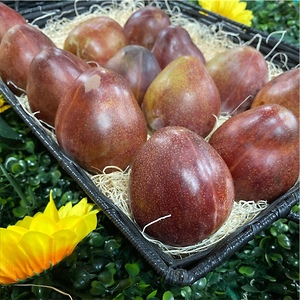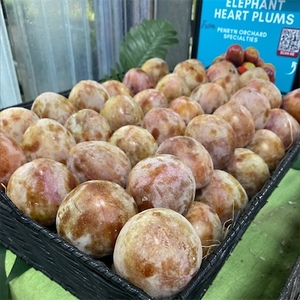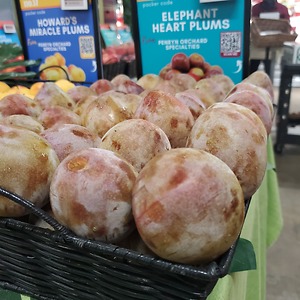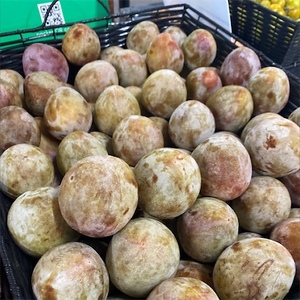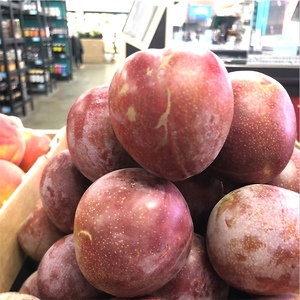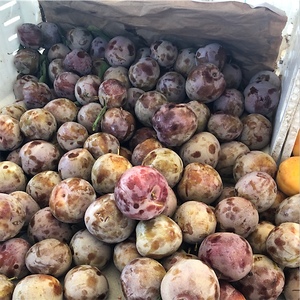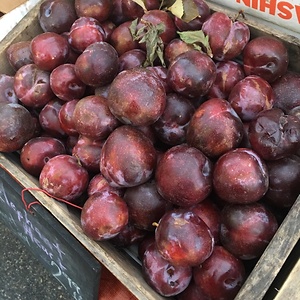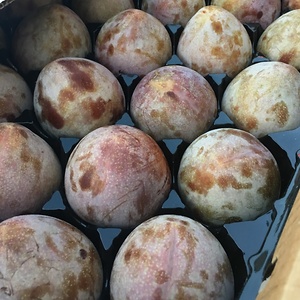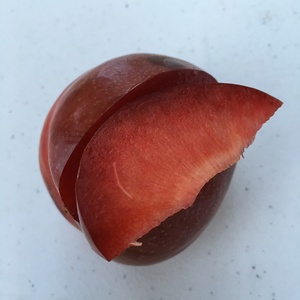

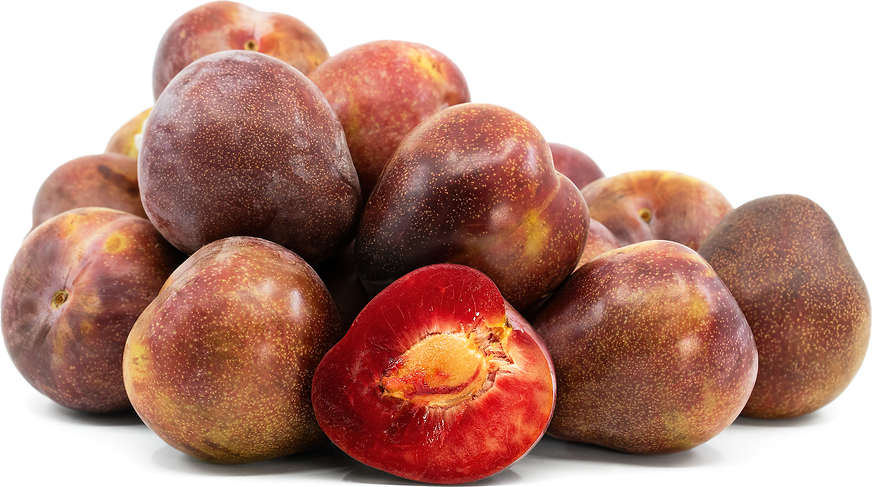
Elephant Heart Plums
Estimated Inventory, 18 lbs : 0
Description/Taste
Elephant heart plums are larger than the common variety and typically average 7 to 8 centimeters in diameter. The fruits are oblong with rounded shoulders that taper to a gentle point on the non-stem end, faintly resembling the shape of a heart. The skin is smooth, powdered, and taut, covered in light yellow mottling, and ripens from green-bronze to purple-red with maturity. Underneath the tough skin, the flesh is firm, dense, aqueous, and crisp, flushed with ruby red, crimson, and golden hues. There is also a central, fibrous pit that is free-standing and not firmly adhered to the flesh. Elephant Heart plums have a tart, sweet, and floral flavor with prominent notes of vanilla and berries.
Seasons/Availability
Elephant Heart plums are available in the mid to late summer.
Current Facts
Elephant Heart plums, botanically classified as Prunus salicina, are a rare variety belonging to the Rosaceae family. The large fruits are considered to be a freestone plum, meaning the central pit is not tightly adhered to the flesh, and are valued for their crisp texture and complex flavorings. Elephant Heart plums are one of the last plum varieties to ripen in the season and are sometimes known as Blood plums, named for their crimson hues. Despite their unique coloring, Elephant Heart plums are only grown by a few specialty farms and home gardeners throughout California. The variety is considered to be extremely delicate, bruising easily, and must be hand-picked and hand-packed when ripe. Due to their complicated cultivation process, Elephant Heart plums have fallen out of favor among commercial growers and have become an uncommon variety found through select farms.
Nutritional Value
Elephant Heart plums are an excellent source of vitamin C, which is an antioxidant that can help strengthen the immune system and reduce inflammation. The plums are also a good source of vitamin A, fiber, and copper, and provide some potassium, magnesium, and vitamin K, which contribute to bone growth and protection.
Applications
Elephant Heart plums are best suited for fresh eating, as their complex flavoring is showcased when consumed straight, out-of-hand. The flesh easily separates from the stone and can be sliced thin, tossed into salads, or displayed on cheese platters. Elephant Heart plums are also favored for fresh applications to highlight their multi-colored flesh. The plums can be cooked to make jams, compotes, reductions, and syrups, developing a silky texture when heated. They can also be used as a flavoring in desserts such as cakes, tarts, and pies, or they can be pickled for extended use. Elephant Heart plums pair well with vanilla, nutmeg, fruits such as figs, raspberries, and citrus, chile peppers, meats such as cured pork, roasted lamb, and poultry, fish, shellfish, hazelnuts, and cheeses such as burrata and manchego. The fresh fruits can be stored up to seven days in the refrigerator.
Ethnic/Cultural Info
In 1974, Luther Burbank’s experimental farm was saved by the Western Sonoma County Historical Society from destruction and became listed on the National Register as a historic place. The Sonoma County acreage is smaller than Burbank’s original, eighteen-acre farm, now spanning only three acres, but many of the original fruit trees that Burbank used in his studies are still found on the property. Elephant Heart plums were first developed at the farm, and during the research years or 1885 to 1926, Burbank created over eight hundred new varieties of fruits, vegetables, flowers, and nut trees. Visitors can tour the farm to view the plants within the orchard and can also walk through exact replicas of a small cottage and barn that Burbank used. Seventeen miles away from the experimental farm, there is also a Luther Burbank Garden in the middle of downtown Santa Rosa, in honor of the horticulturist.
Geography/History
Elephant Heart plums were developed by horticulturist and pioneer of agricultural science, Luther Burbank, in the early 20th century in Sonoma County, California. Burbank was heavily invested in bringing Asian and European varieties of familiar fruits, specifically apricots, cherries, and plums into his plant breeding program. Burbank drew upon the genetic diversity of these species to develop hybrid varieties that would thrive in the growing regions of California. Through hand pollination and careful cultivation techniques, Elephant Heart plums were created from a Japanese plum cultivar and were introduced to the market through Stark Brothers in 1929. Today Elephant Heart plums are considered a boutique variety, grown by a limited number of small farms, and are found through farmer’s markets and specialty grocers primarily in California.
Recipe Ideas
Recipes that include Elephant Heart Plums. One
Podcasts



